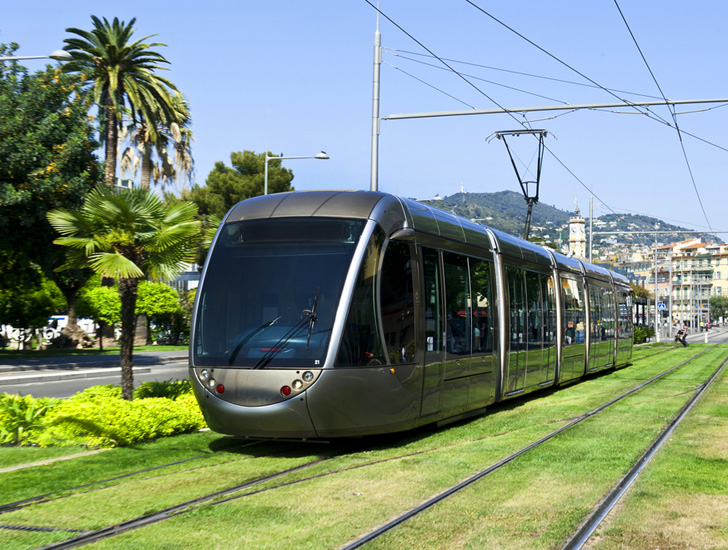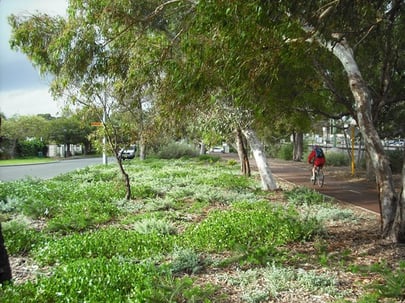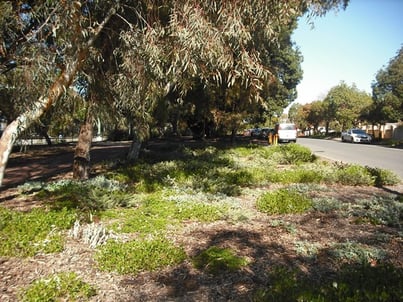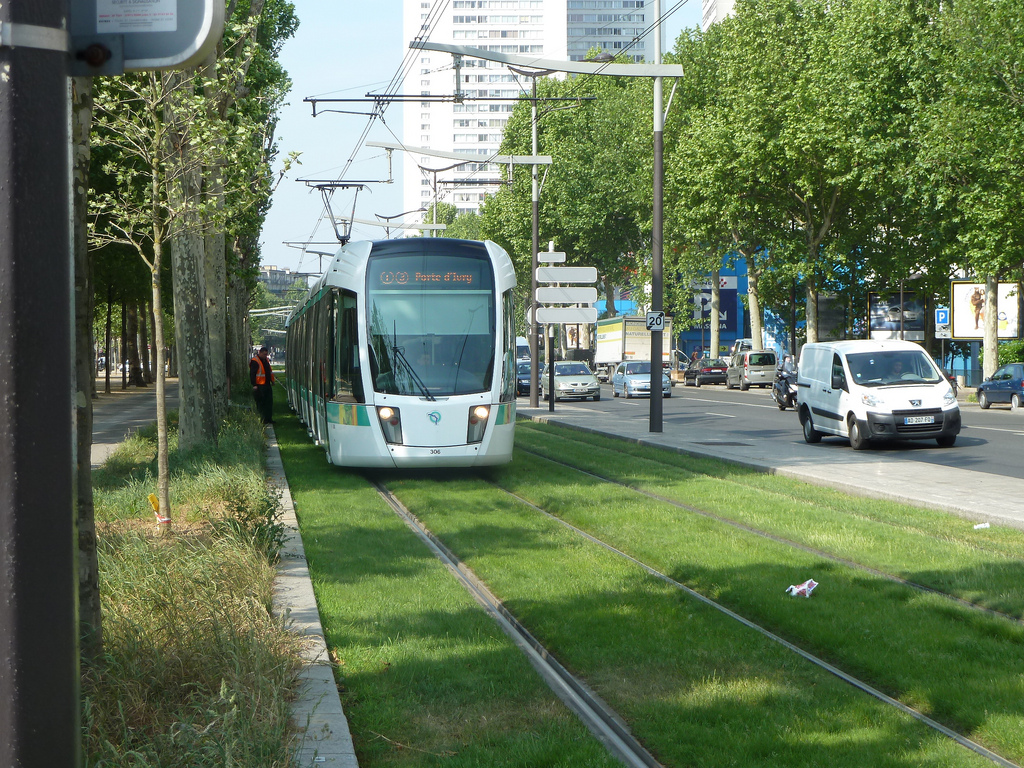Due to the effects of world-wide urbanization trends, the number of human populations exposed to traffic emissions and high-volume railways is rising. Transit-oriented development brings traffic activity ever closer to people’s residences, making them susceptible the effects of air pollution, including particulate matter (PM), gaseous pollutants, and toxins. (1)
Field studies conducted around the world have shown that pollution levels are highest within 100 to 150 meters from the road, yet high concentrations of pollutants can also linger as far as 300 to 500 meters away from the source. The solution seems to lie in cutting down traffic in the most vulnerable areas, but this can also lead to certain undesired effects. Although reducing motorized transport can have a major impact on reducing harmful emission levels, plans to reduce transit through certain areas can cause increased concentrations of traffic along major corridors. Ways to reduce the exposure of people residing and working near high-volume roadways and railways need to be developed if we are to continue with our ever more urbanized way of life. (1)
The EU-s Green Infrastructure Strategy and the Transport Sector
The European Commission has recognized transport to be responsible for around a quarter of EU greenhouse gas emissions, making it the second biggest greenhouse gas-emitting sector after energy. Transport also has a significant impact on biodiversity through ecosystem destruction and fragmentation. Aside from that, transport infrastructure is also vulnerable extreme weather events, such as floods, landslides and avalanches. To help mitigate the problem, The European Commission has proposed The Green Infrastructure Strategy to encourage and guide the implementation of those solutions. (2)
When it comes to transport, the EU’s goal is to reduce the carbon footprint and negative effects of land uptake while boosting opportunities to include ecosystem and biodiversity concerns into policy and planning. Green infrastructure also has the capacity to boost natural disaster resilience by integrating vegetation and permeable materials to provide a sustainable drainage system, reducing both stormwater management costs and water pollution. To sum it up, the EU Green Infrastructure Strategy strives for the long-term conservation of nature and biodiversity, reducing the carbon footprint of the transport sector, maintaining ecological coherence in the landscape and also, as a happy coincidence, improving the visual aspects of road and railway travel, boosting tourism by engaging the scenic impact of greenery. (2)

Photo source (A): https://inhabitat.com/europes-grass-lined-green-railways-good-urban-design/
Green Infrastructure in cities and street canyon environments
Green infrastructure in the built environment is emerging as a planning solution for improving air quality as well as enhancing the sustainability of cities for growing urban populations, yet its implementation requires further research for best results. Urban vegetation removes gaseous pollutants by absorption through leaf stomata or plant surfaces, which improves air quality. However, certain types of plants also emit high amounts of pollen, further adding to the pollution, and should be avoided. In general, various types of vegetation as well as its volume and thickness bring forth varying results that is why we must look at research before any planning and planting takes place. (3)
Street canyons are a commonly found urban feature that consists of buildings along both sides of the road. Introducing trees into those environments to alleviate the effects of traffic pollution may seem like the obvious solution, yet it may have adverse effects. Trees with their dense canopies can reduce the wind speed in a street canyon, resulting in reduced air exchange between the air above and within the canyon, leading to further accumulation of pollutants and even worsening it by 20-96%, according to various studies. The studies indicate that lower types of vegetation, such as and shrubs and hedges are therefore better at limiting the effects of pollution in most cases, especially in street canyons. (3)
Modelling vegetation barriers for best results
Roadside vegetation barriers need to be planned in ways that allow them to absorb pollution sources as efficiently as possible. Vegetation barriers with a porosity of 20 to 40 percent have been suggested, otherwise they can cause non or even the opposite effect. At porosity of less than 20 percent, for instance, vegetation acts more like a solid structure and can increase turbulence. Conifers appear to be superior to deciduous trees because of their year-round foliage and greater amounts of leaf and stem surface area. Their demand for water, however, is also greater for the same reason. This is why, when it comes to green infrastructure, there is no single recipe for success. All designs should take into account the site’s purpose and its context to achieve optimal performance. (1)


Green transit projects are popping up around the world
In Europe, many cities use the tram transportation system in urban centres. Some of them have looked at the tram rail infrastructure as a potential green space, and today, from Barcelona to the Czech Republic, Frankfurt, St-Etienne and Strasbourg, these public transit greenways are showing the potential of incorporating landscaping into good urban design. (4)
Australia is also at the forefront when it comes to green infrastructure implementation. With almost 400 kilometres of rail corridors, Sydney has recognized the potential to use the space alongside the tracks for vegetation spaces that can offset carbon emissions from railway operations. The city is already running pilot projects expected to not only improve air quality, reduce pollution and storm water flows, mitigate urban heating and deliver biodiversity gains, but also improve urban design and property values. (5) A Rail Transit Corridor greening project also runs from the City of Perth to the City of Fremantle, providing travellers with a gorgeous green vista filled with thousands of native trees and shrubs. (5)

Photo source (C): http://www.railforthevalley.com/wp-content/uploads/2014/11/5683901822_12fc731d95_b.jpg
Urbanscape® green transit solutions
At Urbanscape® we provide green solutions, suitable for use in roadside vegetation design that are customized to specific projects and specific climate zones. Our solutions will help reduce labour costs at the installation stage and reduce maintenance costs throughout the entire lifetime of the project. The superior water retention qualities of the mineral wool used in our solutions also ensures the vegetation will prosper all year long.
Green Designs on the Move™ however, takes things to another level. The solution is an innovative, lightweight vegetated design scheme, adapted for implementation on moving vehicles, such as cars, trucks, caravans and campers and even boats.
Check how we did the highway greening in Germany and how the living boats in Amsterdam look after our green roof installation.
It’s so easy to green highways, rail- and tramway tracks. A set of several Urbanscape® Green Designs on the Move™ detail drawings (CAD designs) was made to assist architects and other designers with their work.
Find out more about Green Designs on the Move™:
https://www.urbanscape-architecture.com/solutions/green-designs-on-the-move/
Blog written by: Ana Belčič, Studio Miao
Sources:
- (1) Integrating Vegetation and Green Infrastructure into Sustainable Transportation Planning – Richard Baledauf, Greg McPherson, Linda Wheaton, Max Zhang, Tom Cahill, Chad Bailey, Christina Hemphill Fuller, Earl Withycombe and Kori Titus
- (2) Green Infrastructure and the Transport Sector – European Commission
- (3) Air pollution abatement performances of green infrastructure in open road and built-up street canyon environments - A review - K.V. Abhijith, Prashant Kumar, John Gallagher, Aonghus McNabola, Richard Baldauf, Francesco Pilla, Brian Broderick, Silvana Di Sabatino, Beatrice Pulvirenti
- (4) https://inhabitat.com/europes-grass-lined-green-railways-good-urban-design/
- (5) Greening rail infrastructure for carbon benefits - John Blaira, Cielo Roldanb, Sumita Ghoshc , Shih-Hsien Yungc - University of New South Wales (UNSW), Transport for New South Wales (TfNSW), University of Technology Sydney
- (6) https://202020vision.com.au/project/?id=159
Photos sources:
(A) https://inhabitat.com/europes-grass-lined-green-railways-good-urban-design/
(B) https://202020vision.com.au/project/?id=159
(C) http://www.railforthevalley.com/wp-content/uploads/2014/11/5683901822_12fc731d95_b.jpg



